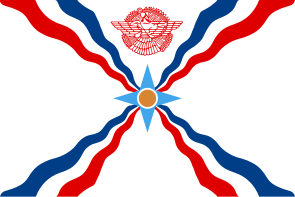
Assyrian continuity is the study of continuity between the modern Assyrian people, a Semitic indigenous ethnic, religious, and linguistic minority in the Middle East, and the people of Ancient Mesopotamia in general and ancient Assyria in particular. Assyrian continuity and Mesopotamian heritage is a key part of the identity of the modern Assyrian people.[1] No archaeological, genetic, linguistic, anthropological, or written historical evidence exists of the original Assyrian and Mesopotamian population being exterminated, removed, bred out, or replaced in the aftermath of the fall of the Assyrian Empire,[2] modern contemporary scholarship "almost unilaterally" supports Assyrian continuity, recognizing the modern Assyrians as the ethnic, linguistic, historical, and genetic descendants of the East Assyrian-speaking population of Bronze Age and Iron Age Assyria specifically, and Mesopotamia in general,[2][3][4][5] which were composed of both the old native Assyrian population[2][3][5] and of neighboring settlers in the Assyrian heartland.[2][a]
Due to an initial long-standing shortage of historical sources beyond the Bible and a handful of inaccurate works by a few later classical authors, many Western historians prior to the early 19th century believed Assyrians to have been completely annihilated, although this was not the view in the region of Mesopotamia itself or surrounding regions, where the name of the land and people continued to be applied.
Modern Assyriology has increasingly and successfully challenged the initial Western perception; today, Assyriologists and historians recognize that Assyrian culture, identity, language, and people clearly survived the violent fall of the Neo-Assyrian Empire and endured into modern times. The last period of ancient Assyrian history is now regarded to be the long post-imperial period from the 6th century BC century when Assyria was known as Athura, during which the Akkadian language gradually went extinct but other aspects of Assyrian culture, such as religion, traditions, and naming patterns, and the Akkadian influenced East Aramaic dialects specific to Mesopotamia survived in a reduced but highly recognizable form before giving way to specifically native forms of Eastern Rite Christianity.[8]
The gradual extinction of Akkadian and its replacement with Akkadian influenced East Aramaic does not reflect the disappearance of the original Assyrian population;[2] Aramaic was used not only by settlers but was also adopted by native Assyrians and Babylonians,[3] in time even becoming used by the royal administrations of Assyria and Babylonia themselves.[9][10] In fact, the new language of the Neo-Assyrian Empire, the Imperial Aramaic, was itself a creation of the Assyrian Empire and its people, and with its retention of an Akkadian grammatical structure and Akkadian words and names, is distinct from the Western Aramaic of the Levant which replaced the Canaanite languages. In addition, Aramaic also replaced other Semitic languages such as Hebrew, Phoenician, Arabic, Edomite, Moabite, Amorite, Ugarite, Dilmunite, and Chaldean among non-Aramean peoples without prejudicing their origins and identity.[11] Due to assimilation efforts encouraged by Assyrian kings, fellow Semitic Arameans, Israelites, Phoenicians, and other non-Semitic groups such as Hittites, Hurrians, Urartians, Phrygians, Persians, and Elamites deported into the Assyrian heartland are also likely to quickly have been absorbed, self-identified, and been regarded, as Assyrians.[2] The population of Upper Mesopotamia was largely Christianized between the 1st and 4th centuries AD, with Mesopotamian religion enduring among Assyrians in small pockets until the late Middle Ages. Assyrian Aramaic-language sources from the Christian period predominantly use the self-designation Suryāyā ("Syrian") alongside "Athoraya" and "Asoraya"[12][13] The term Suryāyā, sometimes alternatively translated as "Syrian" or "Syriac", is generally accepted to derive from the ancient Akkadian Assūrāyu, meaning Assyrian.[14][15] The academic consensus is that the modern name "Syria" originated as a shortened form of "Assyria" and applied originally only to Mesopotamian Assyria and not to the modern Levantine country of Syria.[16]
Assyrian nationalism centered on a desire for self-determination developed near the end of the 19th century, coinciding with increasing contacts with Europeans, increasing levels of ethnic and religious persecution, along with increased expressions nationalism in other Middle Eastern groups, such as the Arabs, Armenians, Copts, Jews, Kurds, Persians, and Turks.[17] Through the large-scale promotion of long extant terms and promotion of identities such as ʾĀthorāyā and ʾAsurāyā, Assyrian intellectuals and authors hoped to inspire the unification of the Assyrian nation, transcending long-standing religious denominational divisions between the Assyrian Church of the East, its 17th century offshoot, the Chaldean Catholic Church, the Syriac Orthodox Church, and various smaller largely Protestant denominations.[17] This effort has been met with both support and some opposition in various religious communities; some denominations have rejected unity and promoted alternate religious identities, such as "Aramean", "Syriac", and "Chaldean". Though some religious officials and activists (particularly in the west) have promoted such identities as separate ethnic groups rather than simply religious denominational groups, they are not generally treated as such by international organizations or historians, and historically, genetically, geographically and linguistically these are all the same Assyrian people.[18]
- ^ Butts 2017, p. 605.
- ^ a b c d e f Novák 2016, p. 132.
- ^ a b c Frahm 2017, p. 7.
- ^ Biggs 2005, p. 10.
- ^ a b Saggs 1984, p. 290.
- ^ Parpola 2004, p. 22.
- ^ Valk 2020, p. 77-103.
- ^ Hauser 2017, p. 240.
- ^ Radner 2021, p. 149.
- ^ Luukko & Van Buylaere 2017, p. 319.
- ^ Parpola 2004, p. 15.
- ^ Butts 2017, p. 600.
- ^ Makko 2012, p. 298.
- ^ Benjamen 2022, p. 2.
- ^ Parpola 2004, pp. 16–17.
- ^ Shehadeh 2011, p. 17.
- ^ a b Butts 2017, p. 603.
- ^ Petrosian 2006, pp. 143–144.
Cite error: There are <ref group=lower-alpha> tags or {{efn}} templates on this page, but the references will not show without a {{reflist|group=lower-alpha}} template or {{notelist}} template (see the help page).
© MMXXIII Rich X Search. We shall prevail. All rights reserved. Rich X Search



